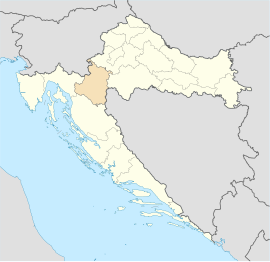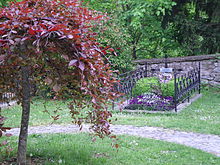Ozalj
| Ozalj | ||
|
||
|
|
||
| Basic data | ||
|---|---|---|
| State : |
|
|
| County : |
|
|
| Area : | 179.4 km² | |
| Residents : | 6,817 (2011) | |
| Population density : | 38 inhabitants per km² | |
| Telephone code : | (+385) 047 | |
| Postal code : | 47 280 | |
| License plate : | KA | |
| Structure and administration (status: 2013, cf. ) |
||
| Community type : | city | |
| Mayoress : | Gordana Lipšinić ( HDZ ) | |
| Postal address : | Kurilovac 1 47280 Ozalj |
|
| Website : | ||
| Others | ||
| Patron saint : | Saint Vitus | |
| City Festival : | 15th June | |
Ozalj is a small town in Croatia , 17 km northwest of Karlovac on the Kupa River. In the north it connects to the Žumberak-Samoborsko gorje nature park .
history
The place was first mentioned in writing in 1244 as a free royal city and imperial city. A medieval fortification was located here, which later became a castle on the right bank of the Kupa River . Ozalj Castle was built on a rock above the Kupa ; At this important river crossing, both the river crossing and the traffic routes at the intersection could be controlled. This explains the continued important historical significance up to the 19th century. It is one of the few facilities that has been continuously inhabited since then.
First belonged Ozalj Castle sexual Babonić , from 1389 the Frankopans and from 1550 on that the Zrinski until 1671. The gothic chapel was Nikola Šubić Zrinski built in 1556; the year is carved over the entrance arch. In 1599 the entrance tower was built by Juraj Zrinski in 1599. Ozalj experienced its heyday in the 17th century as the "unofficial Croatian capital". After the failure of the conspiracy of the Zrinski and Frankopans under Ban Petar Zrinski and his brother-in-law Fran Krsto Frankopan against the Habsburgs in 1670 Leopold I and his tragic execution on April 30, 1671 in Wiener Neustadt , Ozalj was completely plundered and the prosperity of the castle was suddenly interrupted. The nobility and all estates were stripped of the Zrinskis; see also Ana Katarina Frankopan-Zrinski . Franjo Rigoni , an Austrian baron, got it from 1671 to 1702. Benvenuto Petazzi acquired it in 1702. Raimund Perlas owned it from 1725 and it came into the possession of Franjo Perlas until 1766, who rebuilt Ozalj, reconstructed and expanded the castle. The Batthyány family owned it from 1766 to 1872. Theodore Batthyány built the visible baroque part of the castle, and in 1768 he established a cotton production facility; This was followed by a copper factory and a brick factory to redesign the castle. In spite of everything, in contrast to Karlovac , the economy in Ozalj stagnated and thus forced many residents to emigrate around 1880. It was then owned by Thurn und Taxis from 1872 to 1928.
According to its value, the old town of Ozalj belongs to the monuments of the first protection category. The baroque parish church of St. Vitus , which was mentioned as early as 1349, and the imposing Munjara hydroelectric power station from 1908 are also of interest .
In addition to Ozalj, Trg , Jaskovo , Vivodina , Vrhovac , Trescerovac , Gornje Pokulje , Kamanje and Bubnjarci are also mentioned as old settlements . The area around the Pauline monastery in Svetice is also interesting with valuable early Baroque works by the artist Paul Meister .
Ozalj was granted city rights in 1996.
religion
96% of the population are Catholic, 1% Orthodox.
There are five Catholic parishes in the Ozalj area: three Latin and two Greek Catholic .
The three Latin parishes belong to the Archdiocese of Zagreb :
- St. Vitus, Ozalj
- St. Kosmas and Damian, Vrhovac
- St. Lawrence, Vidovina
The two Greek Catholic parishes are assigned to the Žumberak deanery in the Žumberak vicariate of the Križevci diocese :
- St. Anthony Abbot, Kašt
- Resurrection of the Lord, Radatovići
Personalities
- Andrea Ćupor, Miss Croatia 2000
- Slava Raškaj (1877–1906), born in Ozalj, important Croatian watercolor painter, pupil of the famous Bela Cikos .
- Theodor Batthyani (died 1813), during the renovation of the old town of Ozalj, he set up linen and brick factories.
- Emilij Laszowski (1868–1949) historian, wrote the book The town of Ozalj and its surroundings ; he was a member of the "Brothers of the Croatian Dragon", to whom the maintenance of the old town of Ozalj and the establishment of the museum collection is owed.
Web links
- ozalj community - unofficial website
- Website of the city of Ozalj
- Surroundings of Ozalj
- Website tourism







